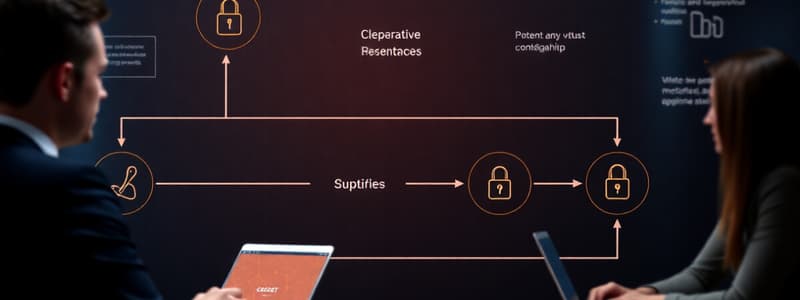Podcast
Questions and Answers
What is the primary purpose of a formal approval process in change management?
What is the primary purpose of a formal approval process in change management?
- To assess the risk and benefits of proposed changes (correct)
- To document the changes made in the organization
- To communicate changes to all employees
- To ensure swift implementation of changes
What role does ownership play in the change management process?
What role does ownership play in the change management process?
- It is necessary for designing the backout plan
- It allows stakeholders to veto changes
- It dictates who should approve the change
- It ensures accountability for the proposed change (correct)
Why is impact analysis important before implementing a change?
Why is impact analysis important before implementing a change?
- To evaluate the impact on business aspects including security (correct)
- To streamline the testing process
- To gather feedback from unrelated departments
- To finalize the maintenance window
What is a backout plan designed to do in the context of change management?
What is a backout plan designed to do in the context of change management?
When should a maintenance window typically be set for implementing changes?
When should a maintenance window typically be set for implementing changes?
What is the function of documented test results in the change management process?
What is the function of documented test results in the change management process?
What is typically restricted during the change process to minimize risk?
What is typically restricted during the change process to minimize risk?
How should the details of change implementation be documented?
How should the details of change implementation be documented?
What is a potential consequence of restarting services or applications during a change management process?
What is a potential consequence of restarting services or applications during a change management process?
How should documentation be handled when changes are made in a system?
How should documentation be handled when changes are made in a system?
Which aspect of change management is highlighted as essential for minimizing security vulnerabilities?
Which aspect of change management is highlighted as essential for minimizing security vulnerabilities?
What is the primary function of version control in the change management process?
What is the primary function of version control in the change management process?
What should be considered regarding legacy applications during a change?
What should be considered regarding legacy applications during a change?
What role does change ownership play in change management?
What role does change ownership play in change management?
What is a backout plan in the context of change management?
What is a backout plan in the context of change management?
Which statement best summarizes the importance of stakeholder communication during changes?
Which statement best summarizes the importance of stakeholder communication during changes?
Flashcards
Change Management Process
Change Management Process
A structured approach to implementing changes, ensuring security and minimizing disruption.
Approval Process
Approval Process
Formal process for reviewing and authorizing changes, considering risk and benefits.
Change Owner
Change Owner
Person responsible for a change, ensuring accountability and implementation.
Stakeholders
Stakeholders
Signup and view all the flashcards
Impact Analysis
Impact Analysis
Signup and view all the flashcards
Test Results
Test Results
Signup and view all the flashcards
Backout Plan
Backout Plan
Signup and view all the flashcards
Maintenance Window
Maintenance Window
Signup and view all the flashcards
Security Implications of Service Restart
Security Implications of Service Restart
Signup and view all the flashcards
Legacy Application Impact
Legacy Application Impact
Signup and view all the flashcards
Dependencies during Change
Dependencies during Change
Signup and view all the flashcards
Change Management Approval Process
Change Management Approval Process
Signup and view all the flashcards
Backout Plan Purpose
Backout Plan Purpose
Signup and view all the flashcards
Version Control Importance
Version Control Importance
Signup and view all the flashcards
Technical Implications during Change
Technical Implications during Change
Signup and view all the flashcards
Change Management Documentation
Change Management Documentation
Signup and view all the flashcards
Study Notes
Change Management Processes
- Change is unavoidable, especially in tech-reliant organizations.
- Change management processes are crucial for security.
- Approval process: formal, board/committee overseen, risk/benefit assessment.
- Ownership: assigned to the proposer or implementer, ensuring accountability.
- Stakeholders: those affected, kept informed and feedback gathered.
- Impact Analysis: thorough evaluation, considering business and security implications.
- Test Results: documented, reviewed after controlled testing, ensures feasibility without disruption.
- Backout Plan: contingency plan for reversing changes if necessary, to minimize impact.
- Maintenance Window: designated time for implementation, often during off-peak hours.
- Standard Operating Procedure (SOP): detailed steps, acts as a guide for future use.
- Security Checkpoints: each step acts as a safety check-point in the change process.
Technical Implications
- Allow/Deny Lists: firewall rules or access controls may need updating.
- Restricted Activities: certain actions might be restricted during the change process to limit risk.
- Downtime: potential system downtime, consider security implications.
- Service/Application Restart: temporary vulnerabilities may emerge during restarts.
- Legacy Applications: need to account for older, less secure systems.
- Dependencies: other systems may be affected by changes, security impact assessment required.
Documentation
- Updating Diagrams: network diagrams and system architectures, should reflect changes.
- Updating Policies/Procedures: incorporate changes into security policies, ensuring alignment.
- Version Control: maintains a history of changes (who, what, when) for auditing and potential rollback. Version control is a safety measure in the change process.
Studying That Suits You
Use AI to generate personalized quizzes and flashcards to suit your learning preferences.


